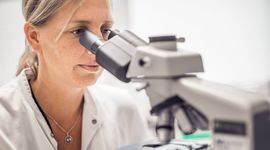EB gene therapies and the role of epigenetics
New scientific publications from the EB House
Researchers of the EB House have recently published an update on the status of available ex vivo gene therapies for EB and those under development. In another article they explained the phenomenon of epigenetics that might influence the success of such therapies, and disease outcomes in general.
As the skin is continuously exposed to mechanical and chemical stress, it has to be renewed every 4 weeks to maintain its barrier function against infections and water loss. A small number of stem cells residing in the skin make this possible by self-renewing themselves and generating new upper skin cells throughout our lives. However, the number of stem cells decreases with age and due to chronic wounds, such as those associated with EB. For this reason, an EB gene therapy, in which stem cells are removed from the skin, corrected outside the body (= ex vivo) and grafted back onto skin wounds, should be carried out at early age.
Two types of ex vivo gene therapy approaches are in the focus of EB research. In classic gene therapy, already applied in clinical trials for EB patients, a healthy copy of the mutated gene is inserted into the stem cells with the help of a virus. This type of strategy involves the risk to accidentally activate other genes that might lead to cancer formation. However, no such events were reported in clinical trials for EB. The more recently developed gene editing methods such as CRISPR use virus-free methods to introduce repair molecules into the cells where they permanently correct the genetic defect. The delivery molecules are degraded upon correction, minimising potential adverse effects.
While grafting of genetically corrected stem cells onto wounded skin has shown a long-term benefit in some junctional EB patients with Laminin 332 mutations, the same procedure was less successful in dystrophic EB patients. In these patients the healthy collagen 7 protein was only produced for a short period of time. This leads to the assumption that the success of stem cell correction depends not only on the age of the patient, but also on the genes involved, the tissue environment, and other factors. Researchers discovered in recent years that epigenetics plays a major role in stem cell maintenance and thus might impact the success of an ex vivo gene therapy.
Epigenetics deals with changes in the DNA, that alter the activity of genes but do not result from mutations. Epigenetics is influenced by various environmental factors, such as diet, stress, drugs, polluants and many more. The best known epigenetic mechanisms involve tagging of the DNA, or the DNA-binding proteins, with tiny chemical molecules. These tags can lead to the unforseen production or inactivation of proteins, which in turn can cause cancer formation, premature aging, and the development of diseases.
Epigenetic modifications in EB remain underexplored, but its contribution to stem cell maintenance, health and disease is profound. This explains why EB patients with exactly the same mutation and genetically identical twins with EB can exhibit different disease outcomes. A better understanding of the molecular mechanisms behind epigenetics could open up new avenues for therapeutic approaches.
To access the articles please click here:

